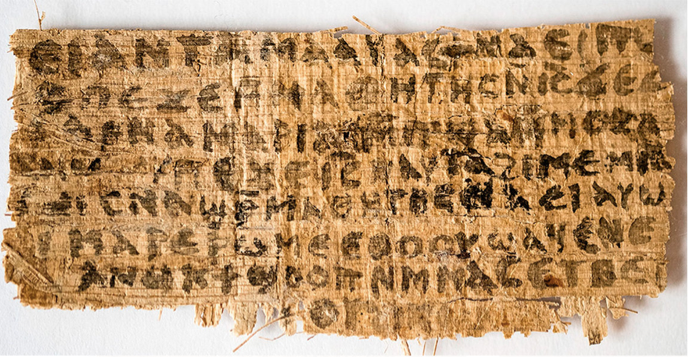We’ve come to another round in the debate over whether a scrap of paper that makes reference to Jesus having a wife is a fake, and it lands in the “probably a forgery” column.
The papyrus fragment contains the phrase “Jesus said to them, ‘My wife …’ ” Harvard’s Karen King made it public in 2012. Then other scholars questioned its authenticity. Then, last month, a group of scientists from Columbia, Harvard, and MIT concluded that it was most likely real based on analysis of its paper and ink. But now Christian Askeland, a specialist at Indiana Wesleyan University, has thrown another wrench into the works. Jerry Pattengale, executive director of the Green Scholars Initiative of which Askeland is a part, took to the Wall Street Journal last week with the update, which regards another text publicized by King, known as the Gospel of John. King says she got the Gospel of John from the same source as the Jesus’ wife papyrus.
Mr. Askeland found, among the online links that Harvard used as part of its publicity push, images of another fragment, of the Gospel of John, that turned out to share many similarities—including the handwriting, ink and writing instrument used—with the “wife” fragment. The Gospel of John text, he discovered, had been directly copied from a 1924 publication.
The Gospel of John fragment turns out to be worded exactly the same, down to the line breaks, as an authentic artifact discovered in Egypt in the 1920s.
And if the Gospel of John fragment is 1) a fake and 2) made from the same ink with the same writing implement as the Jesus’ wife fragment, then the Jesus’ wife fragment must be a fake as well, right? Even King says as much, in the Times:
“This is substantive, it’s worth taking seriously, and it may point in the direction of forgery,” Karen L. King, the historian at Harvard Divinity School, said in a telephone interview, her first since the recent developments. “This is one option that should receive serious consideration, but I don’t think it’s a done deal.”
The Times notes that Askeland’s theory might have some potential holes of its own, and hints—tantalizingly, to the many aficionados of this story!—at the possibility that it could eventually lead to the revelation of the identity of the anonymous donor who gave King the controversial fragments in the first place.
